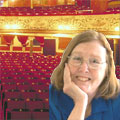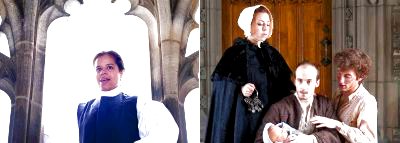- By Judith Pratt
- Entertainment
 Print
Print  With a gloriously melodramatic plot, a cast of 25, a dozen singers in the Handel chorus, and a four-person offstage orchestra, Coram Boy, at Ithaca College, cries out for the phrase "Dickensian epic." Developed by the National Theatre of England, adapted by Helen Edmunson from the novel by Jamila Gavin, Coram Boy went on to Broadway, and a film is in the works.
With a gloriously melodramatic plot, a cast of 25, a dozen singers in the Handel chorus, and a four-person offstage orchestra, Coram Boy, at Ithaca College, cries out for the phrase "Dickensian epic." Developed by the National Theatre of England, adapted by Helen Edmunson from the novel by Jamila Gavin, Coram Boy went on to Broadway, and a film is in the works. It all takes place in the early days of England's Industrial Revolution, when the rich amassed fortunes on the backs of the poor. Born to such riches, Alexander Ashbrook only wants to study music. Denied this by his autocratic father, he runs away, leaving the governess' daughter Melissa with child-who is placed in the Coram foundling hospital and grows up to love music. Baby killing, white slavery, an evil housekeeper, a gentle madman, a happy ending-Coram Boy has it all.
Director Norm Johnson has done a remarkable job of pulling all this into a compelling evening, even though the play runs three hours. He also creates many stunning moments, such as the angelic visions of Mish the madman. (Okay, Mish the mentally challenged, but the character's theatrical background harks way back to King Lear's Mad Tom)
The script lets the highly trained Ithaca College students strut their stuff, and all do so brilliantly. Doubling as young Alexander and his son Arron, Megan Ort's shining soprano voice and energetic charm would steal the show from a less accomplished cast. Other particular standouts are Deanalis Resto as the boy Thomas Ledbury, John Gardner as the evil Otis Gardiner, Hallie Angelella as Mrs. Hendry, and Jessica Bennett as Toby.
 Deanalis Resto (left) as Young Thomas Ledbury. The Evil Trio: Hannah Wenzel, John Gardner, Patrick Mazzella.
Deanalis Resto (left) as Young Thomas Ledbury. The Evil Trio: Hannah Wenzel, John Gardner, Patrick Mazzella.
In a class by himself, Richard Lindenfelzer plays Handel with a choleric and impenetrable German accent, embellishing the drama with glissandos of humor. An angelic choir perched in the stage boxes, sings Handel's music under the able direction of Andy Collopy. By the second act, however, the music becomes as dissonant as the lives of the poor. Interestingly, the original composer, Adrian Sutton, is not credited in the program, leaving us to wonder who created that sublime dissonance.
The set, by Daniel Moss, allows the action to keep moving quickly from the glorious gothic arches of the music school and Ashford estate to the grubby pillars holding up the back streets and foundling hospital. Lighting by Max Doolittle, costumes by Abbey Steere, and sound by Ben Truppin-Brown all helped underscore the contrast between wealth and poverty, ease and suffering.
In his director's notes, Johnson explains how his research for Coram Boy led him to learn about the exploitation of workers by today's manufacturers, and how that infused his production. He begins his notes with a statement by the play's hypocritical villain: "The way a nation treats its poor and unfortunate citizens, most especially its children, is the mark of how civilized it truly is."
Without those notes, however, it's too easy to enjoy Coram Boy as a brilliant melodrama about people from long ago.
v7i14



